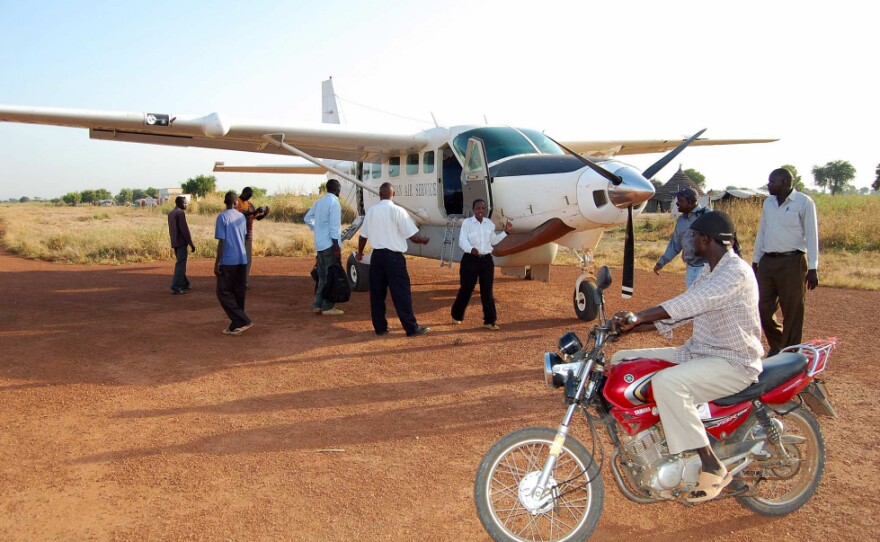NPR's Frank Langfitt has spent the past year reporting in two countries where the populations and the problems could not be more different: South Sudan and China.
The best way to travel in South Sudan is by plane. That's because, in a nation nearly the size of Texas, there are hardly any paved roads.

Small planes are a common way to move around South Sudan, which has few paved roads. Many roads are impassable during rain.
I touched down on a dirt runway in a town of mud and thatched huts. Goi Jooyul Yol, the county commissioner, explained how the lack of infrastructure is holding his people back.
"Akobo is a county that is cut off from the rest of Southern Sudan," he said. "The only way we reach other counties through the state is through the river. We have a seasonal road right now. As soon it starts raining, everything stops."
South Sudan is the world's newest nation and one of its poorest. Its success depends in part on whether it can build enough roads where few exist.
Without tarmac roads, the people of Akobo can't sell their corn and sorghum to outside markets. So, most of its residents remain subsistence farmers or cattle herders, leaving the government with little way to raise revenue and pay for anything.

Children in South Sudan, one of the world's poorest nations, sit in front of traditional homes made of mud and thatch.
The population of sub-Saharan Africa is growing faster than any other region on Earth.
South Sudan has more than 8 million people, and it's been growing in recent years for reasons beyond its fertility rate: Hundreds of thousands of refugees from Sudan's civil war have returned home.
Akobo's schools can't handle the students they already have. The current class size is 200 to 300.
"Some of them don't fit in the classroom," Yol says. "They sit under the tree. When I heard it first, I didn't believe it. But when I went and saw it, it is something mind-boggling."
China
China is mind-boggling in a completely different way. While South Sudan has very little infrastructure, China has built more infrastructure in recent years than any other country. Some Chinese, though, fear the expansion has been too expensive and too fast.
China is the world's most populous country with 1.3 billion people. Most of them are crammed along the country's East Coast.

Despite its ultra-modern skyscrapers and paved streets, some Shanghai residents still transport items on carts.
China has slowed population growth by limiting urban families to one child.
Its challenge is moving the mass of people it already has quickly and efficiently.
China came up with one answer nearly a decade ago: a magnetic levitation train to one of Shanghai's international airports.
The train glides along a rail and covers about 19 miles in around eight minutes.
But few people actually use the train. One passenger, a businessman surnamed Pan from East China's Shandong Province, explained why.
"The train ticket is expensive, $6," he said. "You have the subway, it's cheaper. For less than a dollar, you can get to your destination."
The Chinese government spent more than $1 billion building Mag-Lev, as it's known, in 2002. Last year, the train ran at just 20 percent of capacity.
Unlike South Sudan, China has huge financial resources, but the lesson of Mag-Lev is this: You don't just need money to handle a large population. You need to be careful where you spend it.
China is now focused on building a huge network of high-speed trains.
Chinese rail travel has often been a slow, crowded ordeal, but the bullet trains are changing that. Zheng Zhongyu, an acting student in Shanghai, says trips to Beijing are so much better these days.
"Before the train took 13 hours, now it's five hours," says Zheng, waiting outside the Shanghai Railway Station. "When I would take the train home, I couldn't buy tickets. I'd have to stand the whole night. Now, buying tickets is very convenient."
But last summer, two bullet trains collided, killing 40 people. The government blamed a lightning strike, but delayed releasing a report.
The crash left many Chinese uneasy. Some feel their government is building too much infrastructure too fast, because it can.
Back in South Sudan's Akobo County, a problem like that is unimaginable and the needs of the population more basic. What Akobo requires — and is in the process of getting — is just a road people can drive on in the rain.
Copyright 2022 NPR. To see more, visit https://www.npr.org. 9(MDAzMjM2NDYzMDEyMzc1Njk5NjAxNzY3OQ001))







